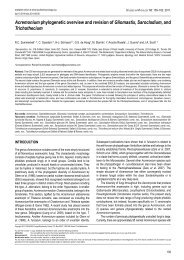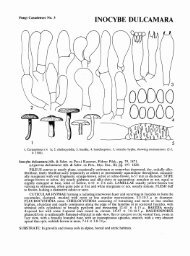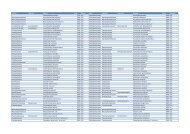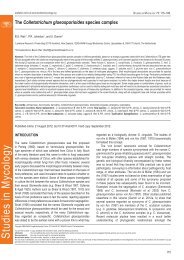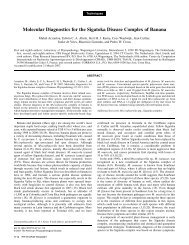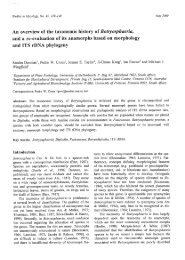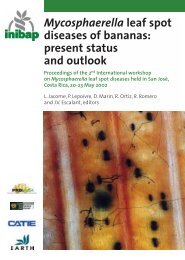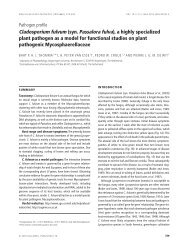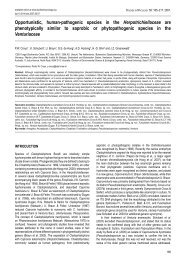Hypocrea rufa/Trichoderma viride: a reassessment, and ... - CBS
Hypocrea rufa/Trichoderma viride: a reassessment, and ... - CBS
Hypocrea rufa/Trichoderma viride: a reassessment, and ... - CBS
You also want an ePaper? Increase the reach of your titles
YUMPU automatically turns print PDFs into web optimized ePapers that Google loves.
one or a few phialides along the length or rebranching,<br />
each secondary <strong>and</strong> terminal branch terminating in 1–4<br />
phialides, a single watery drop of conidia held at the tip<br />
of each phialide. Phialides slightly swollen in the middle<br />
or tapering uniformly from base to tip, straight, curved<br />
or sinuous, (8.7–)10–15(–17) μm long, 2.0–3.0(–4)<br />
μm at the widest point, (1.5–)2.0–2.2(–2.5) μm at the<br />
base, L/W = (0.7–)0.8–1.0(–1.3) (n = 30), arising from<br />
a (1.7–)2.0(–2.5(–3.0) μm wide cell. Conidia (Fig. 15h)<br />
subglobose, (2.5–)3.0–3.7(–4.0) × (2.2–)2.7–3.2(–3.5)<br />
μm (n = 30), smooth, pale green. Chlamydospores<br />
(Fig. 15i) abundant on SNA, terminal <strong>and</strong> intercalary,<br />
(7.0–)8.0–8.7(–10.0) × (6.5–)7.7–9.5(–10.5) μm (n =<br />
30).<br />
Habitat: Endophytic within woody tissues of Scalesia<br />
pedunculata (Asteraceae), the “Daisy Tree” of the<br />
Galapagos isl<strong>and</strong>s.<br />
Holotype: Ecuador, Galapagos Isl<strong>and</strong>s, Santa Cruz, Mt. Cocker,<br />
isolated from stem of Scalesia pedunculata (Asteraceae), 19 May<br />
2000, H.C. Evans W2022d (BPI 872181; ex-type culture G.J.S. 03-<br />
74 = <strong>CBS</strong> 120069).<br />
Notes: <strong>Trichoderma</strong> scalesiae produced conidia only<br />
sparingly <strong>and</strong> then only on SNA to which sterile filter<br />
paper squares had been added. In <strong>Trichoderma</strong> the<br />
coconut-like odour is typical of sect. <strong>Trichoderma</strong>;<br />
thus even in the absence of conidia this species was<br />
predicted to be a member of that section. Normal<br />
<strong>Trichoderma</strong> species produce conidia abundantly on<br />
common mycological media. In the current work we<br />
have found that conidial production on CMD <strong>and</strong> PDA<br />
can be unreliable, whereas the carbohydrate-poor SNA<br />
can be relied on to stimulate conidial production. In the<br />
case of T. scalesiae presumably the cellulose content<br />
of filter paper was an absolute requirement for conidium<br />
production. We did not attempt to stimulate conidium<br />
production on other media by adding filter paper squares<br />
to them. Most likely, if this species had been seen in the<br />
past it would have been recorded as being sterile. The<br />
recently described T. paucisporum Samuels, Suarez &<br />
Solis, also a member of sect. <strong>Trichoderma</strong>, is similar to<br />
T. scalesiae in that it produces conidia sparingly on SNA,<br />
although it does produce conidia in very low numbers<br />
<strong>and</strong> sporadically on CMD <strong>and</strong> SNA. Filter paper was<br />
not necessary for conidium production on SNA by T.<br />
paucisporum. The conidiophores of T. paucisporum are<br />
morphologically very similar to those of T. scalesiae<br />
(Samuels et al., 2006). Conidiophores in both species<br />
are similar to what were described as synanamorphs<br />
of some <strong>Trichoderma</strong> species by (Chaverri et al. 2004).<br />
<strong>Trichoderma</strong> paucisporum was originally isolated from<br />
Ecuador, from cacao pods infected with Moniliophthora<br />
roreri <strong>and</strong> lying on the ground.<br />
Scalesia species, which are endemic to the<br />
Galapagos Isl<strong>and</strong>s, are considered to be the plant<br />
equivalents of Darwin’s finches. Scalesia pedunculata,<br />
a tree, is the largest of the daisy trees. For information<br />
concerning S. pedunculata see references found at<br />
http://www.arkive.org/species/GES/plants_<strong>and</strong>_algae/<br />
Scalesia_penduculata/more_info.html. In addition to T.<br />
scalesiae, we have also identified T. harzianum Rifai<br />
as an endophyte in trunks of S. pedunculata (Samuels,<br />
unpubl.).<br />
DISCUSSION<br />
HYPOCREA RUFA / TRICHODERMA VIRIDE<br />
This is the eighth article in our series dealing with<br />
members of the phylogenetically <strong>and</strong> taxonomically<br />
complex <strong>Trichoderma</strong> sect. <strong>Trichoderma</strong> (Dodd et al.<br />
2002, 2003, Druzhinina et al. 2004, Holmes et al. 2004,<br />
Lieckfeldt et al. 1999, Lu & Samuels 2003, Samuels et<br />
al. 1999, 2006a, b).<br />
In the introduction to the current work we suggested<br />
that reports of T. <strong>viride</strong> refer to more than one species.<br />
We have shown that even the classical morphological<br />
concept of T. <strong>viride</strong>, i.e. a green-conidial species with<br />
globose, warted conidia, is paraphyletic. In the present<br />
paper we distinguish the two most common species<br />
of <strong>Trichoderma</strong> that have warted conidia <strong>and</strong> describe<br />
a new species that has warted conidia, T. vinosum.<br />
We augment the known diversity of morphological<br />
expression in <strong>Trichoderma</strong> to include the peculiar<br />
Eidamia morphology. During the course of the study,<br />
additional species having warted conidia or that were<br />
closely related to T. <strong>viride</strong> or T. <strong>viride</strong>scens were revealed<br />
to us. In addition we describe a second species, T.<br />
scalesiae, that but for DNA sequence analysis <strong>and</strong><br />
careful examination of cultures on SNA, would be<br />
reported as a sterile unknown fungus. Although we<br />
present results from sequencing of only a single<br />
gene, tef1, the resulting clades conform to phenotypic<br />
apomorphies in defining species. Clearly, from Fig.<br />
1 it can be seen that additional species remain to be<br />
characterized. These will be discussed in forthcoming<br />
publications.<br />
In the present work, as in the accompanying article<br />
in this issue that concerns T. koningii (Samuels et al.<br />
2006a), the question that we have had to answer was<br />
how to delimit taxonomic species. As we continue<br />
to collect new specimens <strong>and</strong> submit them to DNA<br />
sequencing <strong>and</strong> phylogenetic analysis, we find<br />
within clades considerable homoplasy in the few<br />
morphological features that are available for analysis.<br />
Despite the formation of a teleomorph by several<br />
species, this morph is so highly conserved within the<br />
<strong>viride</strong> clade as to be virtually useless in species-level<br />
taxonomy while at the same time being diagnostic<br />
of the clade. Similarly, while the basic conidiophore<br />
morphology in the <strong>viride</strong> clade, defined here as “Type<br />
2”, signals membership in the clade, it varies only little<br />
among the species. For this reason, one cannot fault<br />
earlier mycologists for having recognized few species<br />
of <strong>Trichoderma</strong>, or even later mycologists for having<br />
failed to recognize the differences between T. <strong>viride</strong><br />
<strong>and</strong> T. <strong>viride</strong>scens. In both the T. <strong>viride</strong> <strong>and</strong> T. koningii<br />
works our strategy for recognition of taxonomic species<br />
was to closely integrate phenetic <strong>and</strong> phylogenetic<br />
characters. These two analyses were undertaken<br />
independently in two laboratories, <strong>and</strong> therefore<br />
were unbiased. Species were recognized when the<br />
concordance between both approaches were found.<br />
Although we clearly underst<strong>and</strong> that the phylogeny of<br />
one single locus, in this case tef1, is useful to formulate<br />
a hypothesis concerning the phylogeny of the fungus,<br />
we also underst<strong>and</strong> that use of this single gene region<br />
is not powerful enough to falsify a species hypothesis.<br />
175




